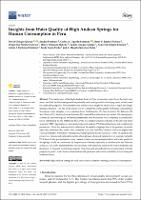Insights from Water Quality of High Andean Springs for Human Consumption in Perú

View/
Date
2021Author(s)
Choque Quispe, David
Froehner, Sandro
Ligarda Samanez, Carlos A.
Ramos Pacheco, Betsy S.
Peralta Guevara, Diego E.
Palomino Rincón, Henry
Choque Quispe, Yudith
Solano Reynoso, Aydeé M.
Barboza Palomino, Gloria I.
Taipe Pardo, Fredy
Zamalloa Puma, Lourdes Magaly
Metadata
Show full item recordAbstract
The headwaters of the high Andean basin in Peru accumulate water from the mist, rain,
snow, and hail, and it is transported superficially and underground to low-lying areas, mostly used
for drinkable purposes. The natural water in these areas might be altered due to legal and illegal
mining extraction. The aim of the study was to evaluate the water quality for human consumption.
Seventeen water samples were examined from Andahuaylas (A), San Jerónimo (S), Talavera (T),
and Chiara (CH) districts located between 2813 and 4004 m altitude in the Andes. We used physic ochemical, microbiological, and metal parameters, and the results were compared to permissible
levels established by the WHO and ECA-Peru to examine samples collected in the dry and rainy
seasons in 2019. Application of principal component analysis (PCA) identified areas and conditioning
parameters. Extractive mining activity influences the quality of springs due to the presence of metals,
especially antimony (Sb), arsenic (As), cadmium (Cd), and lead (Pb), values of which are higher than
values permissible for human consumption, being higher in the dry season (p < 0.05). In addition, the
presence of cations and particulate matter affects physico-chemical parameters, for example turbidity.
PCA showed that parameters for water characterization are season-independent, and water quality in
the springs would be conditioned by the presence of metals, especially in Andahuaylas and Talavera
zones, as well as the parameters that are associated with dissolved solids in the water (turbidity and
fluorides). A frequent monitoring program of springs and groundwater is recommended, with the
purpose to protect water from contamination and guarantee safe water availability in low-lying and
urbanized areas.
Collections
The following license files are associated with this item:
